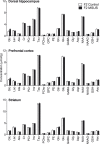Brain metabolic alterations in mice subjected to postnatal traumatic stress and in their offspring
- PMID: 27604311
- PMCID: PMC5531341
- DOI: 10.1177/0271678X16667525
Brain metabolic alterations in mice subjected to postnatal traumatic stress and in their offspring
Abstract
Adverse environmental and social conditions early in life have a strong impact on health. They are major risk factors for mental diseases in adulthood and, in some cases, their effects can be transmitted across generations. The consequences of detrimental stress conditions on brain metabolism across generations are not well known. Using high-field (14.1 T) magnetic resonance spectroscopy, we investigated the neurochemical profile of adult male mice exposed to traumatic stress in early postnatal life and of their offspring, and of undisturbed control mice. We found that, relative to controls, early life stress-exposed mice have metabolic alterations consistent with neuronal dysfunction, including reduced concentration of N-acetylaspartate, glutamate and γ-aminobutyrate, in the prefrontal cortex in basal conditions. Their offspring have normal neurochemical profiles in basal conditions. Remarkably, when challenged by an acute cold swim stress, the offspring has attenuated metabolic responses in the prefrontal cortex, hippocampus and striatum. In particular, the expected stress-induced reduction in the concentration of N-acetylaspartate, a putative marker of neuronal health, was prevented in the cortex and hippocampus. These findings suggest that paternal trauma can confer beneficial brain metabolism adaptations to acute stress in the offspring.
Keywords: Traumatic stress; magnetic resonance spectroscopy; metabolism; neurochemical profile; neurodevelopmental; transgenerational.
Figures




Similar articles
-
Prenatal stress and early adoption effects on benzodiazepine receptors and anxiogenic behavior in the adult rat brain.Synapse. 2006 Dec 15;60(8):609-18. doi: 10.1002/syn.20336. Synapse. 2006. PMID: 17019679
-
Longitudinal neurochemical modifications in the aging mouse brain measured in vivo by 1H magnetic resonance spectroscopy.Neurobiol Aging. 2014 Jul;35(7):1660-8. doi: 10.1016/j.neurobiolaging.2014.01.135. Epub 2014 Jan 31. Neurobiol Aging. 2014. PMID: 24560998
-
In Vivo Neurochemical Characterization of Developing Guinea Pigs and the Effect of Chronic Fetal Hypoxia.Neurochem Res. 2016 Jul;41(7):1831-43. doi: 10.1007/s11064-016-1924-y. Epub 2016 May 27. Neurochem Res. 2016. PMID: 27233245
-
Sexually-dimorphic alterations in cannabinoid receptor density depend upon prenatal/early postnatal history.Neurotoxicol Teratol. 2016 Nov-Dec;58:31-39. doi: 10.1016/j.ntt.2016.09.004. Epub 2016 Sep 12. Neurotoxicol Teratol. 2016. PMID: 27634313 Free PMC article. Review.
-
Brain N-acetyl aspartate concentrations measured by H MRS are reduced in adult male rats subjected to perinatal stress: preliminary observations and hypothetical implications for neurodevelopmental disorders.J Psychiatr Res. 1999 Jan-Feb;33(1):41-51. doi: 10.1016/s0022-3956(98)00043-0. J Psychiatr Res. 1999. PMID: 10094239 Review.
Cited by
-
Environmental Change-Dependent Inherited Epigenetic Response.Genes (Basel). 2018 Dec 21;10(1):4. doi: 10.3390/genes10010004. Genes (Basel). 2018. PMID: 30583460 Free PMC article.
-
1H MRS-based metabolite changes at ventral respiratory control centers of the medulla oblongata following administration of morphine in wild-type and GIRK2 mutant mice.Curr Res Physiol. 2025 May 20;8:100147. doi: 10.1016/j.crphys.2025.100147. eCollection 2025. Curr Res Physiol. 2025. PMID: 40503083 Free PMC article.
-
Challenges of Investigating Compartmentalized Brain Energy Metabolism Using Nuclear Magnetic Resonance Spectroscopy in vivo.Neurochem Res. 2025 Jan 4;50(1):73. doi: 10.1007/s11064-024-04324-4. Neurochem Res. 2025. PMID: 39754627 Free PMC article. Review.
-
Differential susceptibility of male and female germ cells to glucocorticoid-mediated signaling.Elife. 2024 Jan 16;12:RP90164. doi: 10.7554/eLife.90164. Elife. 2024. PMID: 38226689 Free PMC article.
-
Brain structural and functional outcomes in the offspring of women experiencing psychological distress during pregnancy.Mol Psychiatry. 2024 Jul;29(7):2223-2240. doi: 10.1038/s41380-024-02449-0. Epub 2024 Feb 28. Mol Psychiatry. 2024. PMID: 38418579 Free PMC article. Review.
References
-
- Bernet CZ, Stein MB. Relationship of childhood maltreatment to the onset and course of major depression in adulthood. Depress Anxiety 1999; 9: 169–174. - PubMed
-
- Gershon A, Sudheimer K, et al. The long-term impact of early adversity on late-life psychiatric disorders. Curr Psychiatry Rep 2013; 15: Article 354. - PubMed
-
- McGowan PO, Szyf M. The epigenetics of social adversity in early-life: implications for mental health outcomes. Neurobiol Dis 2010; 39: 66–72. - PubMed
MeSH terms
LinkOut - more resources
Full Text Sources
Other Literature Sources
Medical

